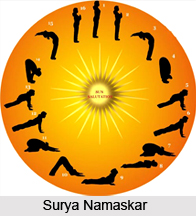 Yoga Asanas comprise several factors that optimize the effectiveness of one`s Yoga Asana regimen. These precautions and considerations are often devised keeping the nature of Yoga Asanas in mind, for instance, it is forbidden to perform Asanas after eating, since several of them exercise the abdominal muscles. Yoga Asanas are best performed during the morning, before breakfast, as the mind is fresh and the limbs can be moved with ease and vigour.
Yoga Asanas comprise several factors that optimize the effectiveness of one`s Yoga Asana regimen. These precautions and considerations are often devised keeping the nature of Yoga Asanas in mind, for instance, it is forbidden to perform Asanas after eating, since several of them exercise the abdominal muscles. Yoga Asanas are best performed during the morning, before breakfast, as the mind is fresh and the limbs can be moved with ease and vigour.
A fifteen-minute daily dose of vigorous physical exercises is a safe standard for average persons. However, the Asanas` static nature and extremely slow movements in the case of dynamic variations may extend the period of Yoga Asanas beyond twenty-five to thirty minutes. If the daily dose is missed, the same should be made good as soon as possible at some other time of the day or; at the latest, the next day. It is highly important to maintain a daily regimen. Regularity in training (Abhyasa) is a fundamental source of success in Yoga Asanas. Practicing regularly at the same time also helps as the exercise is treated as a daily hygienic duty like other calls.
 If morning hours cannot be availed, the best time in the evening is before dinner, provided the practitioner is not tired. Some experts believe that Asanas are better performed in the evening, because the muscles are more pliant then. It may be difficult to practice in the morning, since the muscles are stiff. If that is the case, relaxation poses should be given priority in sequence over other Yoga postures.
If morning hours cannot be availed, the best time in the evening is before dinner, provided the practitioner is not tired. Some experts believe that Asanas are better performed in the evening, because the muscles are more pliant then. It may be difficult to practice in the morning, since the muscles are stiff. If that is the case, relaxation poses should be given priority in sequence over other Yoga postures.
Asanas should not be commenced for an hour and a half after even a moderate quantity of solid food. At least four hours and a half must elapse between a heavy meal and the Asanas. In short, Yoga Asanas should always begin with a light stomach. Practitioners are advised to cleanse the bladder and bowels, clean the nose and throat of all mucus, and drink a glass of plain water and wait 15 minutes before starting with Asanas.
Yoga posture exercises have to be followed with particular zeal and regularity during winter if normal blood circulation is to be maintained and the blood kept warm for uniform good health.




















